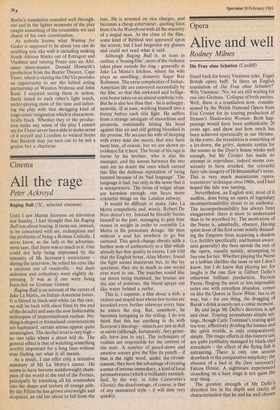Cinema
All the rage
Peter Ackroyd
Raging Bull ('X', selected cinemas) Until I saw Martin Scorsese on television last Sunday, I had thought that his Raging Bull was about boxing. It turns out, instead, to be concerned with sin, redemption and the problems of being a Roman Catholic. I never knew, as the lady in the advertisement says, that there was so much in it. One could not help being impressed by the intensity of Mr Scorsese's convictions — during the interview, he rolled his eyes like a creature out of vaudeville — but their staleness and orthodoxy were slightly depressing. It was as if one were being force-fed on Graham Greene.
Raging Bull is an account of the career of Jake La Motta, an Italian-American boxer. It is filmed in black-and-white (at this rate, we will be back with silent films by the end of the decade) and uses the now fashionable techniques of improvisational realism. Nothing is shaped or formalised; conversations are haphazard; certain scenes appear quite meaningless. The decibel level is very high — no one talks where a shout will do. The general effect is that of watching something terribly important for a long time without ever finding out what it all means.
As a result, I can offer only a tentative summary of Mr La Motta's career. He seems to have become middleweight champion of the world at the end of the Forties, principally by knocking all his contenders into the shape and texture of orange pith. By the Fifties he has grown overweight and dropsical, an old bat about to fall from the tree. He is arrested on vice charges, and becomes a cheap entertainer, quoting lines from On the Waterfront with all the sincerity of a stupid man. At the close of the film, some kind of Biblical text appeared upon the screen; but I had forgotten my glasses and could not read what it said.
Although Raging Bull is, at least in outline, a 'boxing film', most of the violence takes place outside the ring — generally in Jake La Motta's kitchen, where his wife plays an unwilling,/ domestic Sugar Ray Robinson. The eerie complicities of ItalianAmerican life are conveyed successfully by the film, so that this awkward and belligerent boxer takes on an almost symbolic role.
But he is also less than that — he is unhappy, neurotic, ill at ease, working himself into a frenzy before each title fight. He suffers from a strange amalgam of masochism and paranoia, continually hitting his head against thin air and still getting bloodied in the process. He accuses his wife of sleeping with every man she meets; that may have been true, of course, but we are shown no evidence for it here. The brunt of his rage is borne by his brother, who is also his manager, and the scenes between the two men are no doubt the ones which earned this film the dubious reputation of being banned because of its tad language'. The language is bad, but only in the sense that it is unexpressive. The items of vulgar abuse are harmless enough: one hears more colourful things on the London subway.
It would be difficult to make Jake La Motta sympathetic and, wisely, Robert De Niro doesn't try. Instead he literally buries himself in the part, managing to gain four stones in weight in order to resemble La Motta in his premature dotage: the man without a soul has nowhere to go but outward. This quick-change obesity adds a further note of authenticity to a film which already has that quality in excess. I am told that the English boxer, Alan Minter, found the fight scenes inaccurate but, to the lay spectator, they are as much as one would ever want to see. The punches sound like car doors being slammed, the bruises are the size of potatoes, the blood sprays out like water behind a surfer.
This is, I suppose, a film about a slob, a violent and stupid man whose few brains are knocked even further sideways every time he enters the ring. But, somehow, he becomes intriguing in the telling. I do not think that this has anything to do with Scorsese's theology — sinners,are just as dull as saints (although, fortunately, they generally have less to say). The techniques of realism are responsible for the interest of the man. A number of pared-down and emotive scenes give the film its punch — if that is the right word, under the circumstances; they have the advantage of creating a sense of intense immediacy, a kind of local persuasiveness (which is brilliantly exemplified, by the way, in John Cassavetes's Gloria); the disadvantage, of course, is that of any mannered style — it will date very quickly.






































 Previous page
Previous page